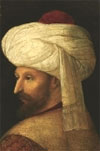|

 |
2 / 5 |
 |
Biography
 Mehmed II, also known as The Conqueror is one of the famous sultans of Ottoman Empire with his intelligence. Mehmed II ruled the Ottoman for a brief time, from 1444 to 1446, after his father. After that time Sultan Murad II renounced the throne but when he died Mehmed II ruled the Ottoman Empire from 1451 to 1481. Mehmet II was a genius statesman and a military leader who was also interested in literature, fine arts and monumental architecture. He was educated by famous scholar Aksemseddin and according to Ottoman historians he was speaking seven languages fluently. Mehmed II, also known as The Conqueror is one of the famous sultans of Ottoman Empire with his intelligence. Mehmed II ruled the Ottoman for a brief time, from 1444 to 1446, after his father. After that time Sultan Murad II renounced the throne but when he died Mehmed II ruled the Ottoman Empire from 1451 to 1481. Mehmet II was a genius statesman and a military leader who was also interested in literature, fine arts and monumental architecture. He was educated by famous scholar Aksemseddin and according to Ottoman historians he was speaking seven languages fluently.
Mehmed II was born as a son of Sultan Murad I and Huma Hatun on the night of 29th binded to 30th March 1432, in Edirne. His early childhood passed on Edirne for a while.
Mehmed II motivated for taking the city of Constantinople by Prophet Hz Muhammeds words for the conqueror of Constantinople decades ago; One day, Constantinople will be conquered. How wonderful and blessed are the commander of its conquest and his soldiers! Sultan Mehmed II, overthrew the Byzantine Empire by conquering Constantinople as consolidating the Ottoman Empire and marking the end of the Middle Ages. He took the name conqueror (fatih) after the conquest of Istanbul on 29th May 1453. The conquest of Istanbul spelled the end of the Byzantine Empire and entered a phase of urban revival under the wise and tolerant administrations of Mehmed and his immediate successors.
The capture of Istanbul was followed by a long succession of campaigns which resulted in a tremendous extension of direct Ottoman rule. After the conquest of the city, Mehmed the Conqueror marched towards Morea and captured the cities of Greece one after another. However, he was threatened from the rear by the principality of Karaman and therefore turned to Anatolia to vanquish them and to annex their territory. He then conquered the area close to western Black Sea and appointed as governor Kızıl Ahmet who was the founder of the principality Isfen-diyar. Afterwards, he fought Uzun Hasan, the ruler of the Akkoyunlus and overcame him.Among those areas that fell to Mehmet II were Serbia, Greece, the Empire of Trezibizond, Wallachia, Bosnia, Karaman, Albania and several Venetian and Geneose maritime establishments.
Mehmed 2nds wifes were Gulbahar Hatun, Gulshah Hatun, Sitti Mukrime Hatun, Cicek Hatun, Helene Hatun, Anna Hatun and Alexias Hatun. He had a daughter named Gevrehan Sultana and sons; Mustafa, Bayezid II (Sultan after Mehmed II), Cem and Korkut. Mehmed II was dressed in the simple and heroic manner of his great grandfather Çelebi Mehmed. His turban consisted of a mücevveze (a tall cylindrical headgear) in military style, wound round with coiled gauze. This special type of turban became fashionable among later sultans.
The Codes of Laws of Mehmed II was very important document for his era. It was a constitution ordering the state men duties and legalizing the fratricide for the order of the empire. This code included establishing various organizational positions, produce a form of law that suited the growing empires geography and state organizations after the conquest of Constantinople.
He ruled the Ottoman Empire for 30 years and joined 25 campaigns himself. He was a very strict statesman and a very brave soldier. The great emperor had died on 3rd May 1481 and he was buried in Fatih Turbesi (tomb), near the Mosque of Fatih in Istanbul. After the Sultans death, the Ottoman Empire remained culturally and geographically strong.
 |
2 / 5 |
 |
|


